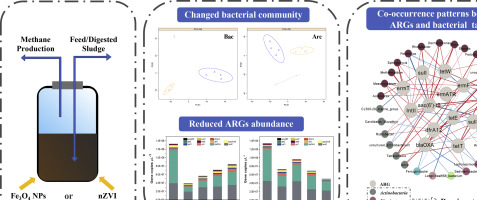当前位置:
X-MOL 学术
›
Sci. Total Environ.
›
论文详情
Our official English website, www.x-mol.net, welcomes your
feedback! (Note: you will need to create a separate account there.)
Evolutions of antibiotic resistance genes (ARGs), class 1 integron-integrase (intI1) and potential hosts of ARGs during sludge anaerobic digestion with the iron nanoparticles addition.
Science of the Total Environment ( IF 8.2 ) Pub Date : 2020-03-26 , DOI: 10.1016/j.scitotenv.2020.138248 Yanru Zhang 1 , Zhaohui Yang 1 , Yinping Xiang 1 , Rui Xu 2 , Yue Zheng 3 , Yue Lu 1 , Meiying Jia 1 , Saiwu Sun 1 , Jiao Cao 1 , Weiping Xiong 1
Science of the Total Environment ( IF 8.2 ) Pub Date : 2020-03-26 , DOI: 10.1016/j.scitotenv.2020.138248 Yanru Zhang 1 , Zhaohui Yang 1 , Yinping Xiang 1 , Rui Xu 2 , Yue Zheng 3 , Yue Lu 1 , Meiying Jia 1 , Saiwu Sun 1 , Jiao Cao 1 , Weiping Xiong 1
Affiliation

|
In this work, we investigated the impact of iron nanoparticle, including magnetite nanoparticles (Fe3O4 NPs) and nanoscale zero-valent iron (nZVI), on the anaerobic digestion (AD) performance. Moreover, the evolutions of antibiotic resistance genes (ARGs), class 1 integrons-integrase (intI1) and potential hosts of ARGs were also investigated. The optimal addition of Fe3O4 NPs and nZVI to promote methane production was 0.5 g/L and 1 g/L, which led to 22.07% and 23.02% increase in methane yield, respectively. The degradation rate of organic matter was also enhanced with the addition of Fe3O4 NPs or nZVI. The results of high-throughput sequencing showed that the reactors with iron NPs exhibited significant differences in microbial community structure, compared to the reactors with the non‑iron NPs. Iron NPs have caused the relative abundance of the dominant bacteria (Proteobacteria, Firmicutes and Actinobacteria) generally decreased, while the dominant archaea (Euryarchaeota) increased in AD sludge. Quantitative PCR results revealed that iron NPs accelerated the reductions in total absolute abundance of ARGs, especially a beta-lactamase resistance encoded gene (blaOXA). Network analysis displayed that the attenuation of ARGs was mainly attributed to the decline of potential hosts (Proteobacteria, Firmicutes and Actinobacteria). Meanwhile, environmental factors (such as pH, soluble chemical oxygen demand and heavy metals) were also strongly correlated with ARGs.
中文翻译:

在添加铁纳米颗粒的污泥厌氧消化过程中,抗生素抗性基因(ARG),1类整合素整合酶(intI1)和潜在的ARG宿主的演变。
在这项工作中,我们研究了铁纳米颗粒(包括磁铁矿纳米颗粒(Fe3O4 NPs)和纳米级零价铁(nZVI))对厌氧消化(AD)性能的影响。此外,还研究了抗生素抗性基因(ARG),1类整合素整合酶(intI1)和ARGs潜在宿主的进化。Fe3O4 NP和nZVI促进甲烷生成的最佳添加量为0.5 g / L和1 g / L,分别导致甲烷产率提高22.07%和23.02%。加入Fe3O4 NPs或nZVI可以提高有机物的降解率。高通量测序的结果表明,与具有非铁NP的反应器相比,具有铁NP的反应器在微生物群落结构上表现出显着差异。铁NPs导致AD污泥中主要细菌(变形杆菌,硬毛和放线菌)的相对丰度普遍降低,而主要古细菌(Euryarchaeota)则相对增加。定量PCR结果显示,铁NP加速了ARG绝对绝对丰度的降低,尤其是β-内酰胺酶抗性编码基因(blaOXA)。网络分析表明ARGs的减少主要归因于潜在宿主(变形杆菌,硬毛和放线菌)的减少。同时,环境因素(例如pH值,可溶性化学需氧量和重金属)也与ARGs密切相关。定量PCR结果显示,铁NP加速了ARG绝对绝对丰度的降低,尤其是β-内酰胺酶抗性编码基因(blaOXA)。网络分析表明ARGs的减少主要归因于潜在宿主(变形杆菌,硬毛和放线菌)的下降。同时,环境因素(例如pH值,可溶性化学需氧量和重金属)也与ARGs密切相关。定量PCR结果显示,铁NP加速了ARG绝对绝对丰度的降低,尤其是β-内酰胺酶抗性编码基因(blaOXA)。网络分析表明ARGs的减少主要归因于潜在宿主(变形杆菌,硬毛和放线菌)的下降。同时,环境因素(例如pH值,可溶性化学需氧量和重金属)也与ARGs密切相关。
更新日期:2020-03-27
中文翻译:

在添加铁纳米颗粒的污泥厌氧消化过程中,抗生素抗性基因(ARG),1类整合素整合酶(intI1)和潜在的ARG宿主的演变。
在这项工作中,我们研究了铁纳米颗粒(包括磁铁矿纳米颗粒(Fe3O4 NPs)和纳米级零价铁(nZVI))对厌氧消化(AD)性能的影响。此外,还研究了抗生素抗性基因(ARG),1类整合素整合酶(intI1)和ARGs潜在宿主的进化。Fe3O4 NP和nZVI促进甲烷生成的最佳添加量为0.5 g / L和1 g / L,分别导致甲烷产率提高22.07%和23.02%。加入Fe3O4 NPs或nZVI可以提高有机物的降解率。高通量测序的结果表明,与具有非铁NP的反应器相比,具有铁NP的反应器在微生物群落结构上表现出显着差异。铁NPs导致AD污泥中主要细菌(变形杆菌,硬毛和放线菌)的相对丰度普遍降低,而主要古细菌(Euryarchaeota)则相对增加。定量PCR结果显示,铁NP加速了ARG绝对绝对丰度的降低,尤其是β-内酰胺酶抗性编码基因(blaOXA)。网络分析表明ARGs的减少主要归因于潜在宿主(变形杆菌,硬毛和放线菌)的减少。同时,环境因素(例如pH值,可溶性化学需氧量和重金属)也与ARGs密切相关。定量PCR结果显示,铁NP加速了ARG绝对绝对丰度的降低,尤其是β-内酰胺酶抗性编码基因(blaOXA)。网络分析表明ARGs的减少主要归因于潜在宿主(变形杆菌,硬毛和放线菌)的下降。同时,环境因素(例如pH值,可溶性化学需氧量和重金属)也与ARGs密切相关。定量PCR结果显示,铁NP加速了ARG绝对绝对丰度的降低,尤其是β-内酰胺酶抗性编码基因(blaOXA)。网络分析表明ARGs的减少主要归因于潜在宿主(变形杆菌,硬毛和放线菌)的下降。同时,环境因素(例如pH值,可溶性化学需氧量和重金属)也与ARGs密切相关。











































 京公网安备 11010802027423号
京公网安备 11010802027423号